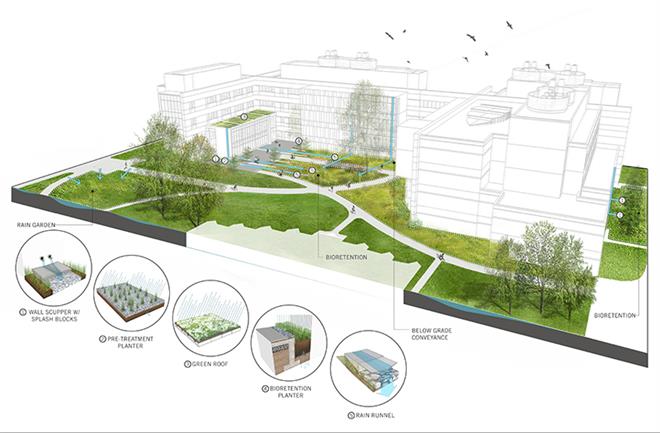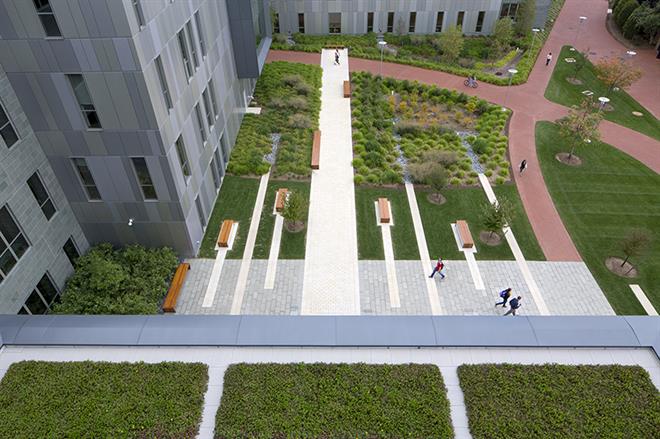Strategies in which Precipitation enters the landscape
- Wall scupper with splash blocks – Water goes off the roof and down the walls through a spout, entering the landscape before it goes into a main water source.
- Pretreatment Planter – Water enters a sand bed that filters pollutants before allowing the water to enter a main water source.
- Green Roof – Water is absorbed by the roof and stays there to be used up by the planted seedem. Any water that cannot be held by the roof enters the landscape through the wall scuppers.
- r – Plant beds slow the process of water being absorbed into the earth.
- Rain Runnel – Channels that bring water from the table area in the courtyard out into the landscape.

Bioretention
Bioretentionis when water comes down from the sky or roof and into a planted area, which holds the water and allows it to absorb into the earth at a slower rate. Therefore, it reduces the possibility of flooding by slowing the process of the rain reaching a main water source. In addition, the plants start cleaning the water and eliminate some of the pollution before it is piped into a river or lake. Originally, a parking lot was located where the Harker Interdisciplinary Science and Engineering (ISE) building now stands. Overall, the changed landscape has reduced the amount of impermeable surface by replacing it with bioretention planters.
The entire back side of the ISE building is a bioretention area containing many plants. These plants were chosen for this particular area because they can survive when there is a prolific amount of water as well as when there is very little water for long periods of time. The plants thrive solely from groundwater – there is no irrigation system. The goal of the landscape is to retain the water on the site and out of the city infrastructure; compared to the previously existing parking lot which allowed the water to drain straight into the main water source at a very fast rate along with pollution. Our system addresses both the quality and quantity of water that is leaving our landscape.

Soil as a Filter
New Castle County has a thick layer of clay soil, making it difficult for storm water to infiltrate into the ground. During construction, over-excavation removed compacted clay soil. After which 3 feet of a special mix of soil (sand, top soil, and composted mulch) was added to provide a filter for stormwater. Stormwater contains nutrients from fertilizers and road salts, which are harmful for ground water. The bioretention system filters out these nutrients, allowing quality groundwater to enter our main water sources.
The Science behind Bioretention
Bioretention works physically, chemically, and biologically to improve water quality. It works mechanically by slowing the water down, chemically by absorbing the nutrients into the soil surfaces, and biologically because the microorganisms in the soil help break down some of the nutrient molecules and digest them. When we over fertilize and nutrients get washed into waterways, they can make waterways and ponds eutrophic (overabundance of nitrogen) creating algal blooms, which in turn kills fish, resulting in a loss of biodiversity. Bioretention units filter out these harmful nutrients before they enter the waterways.
